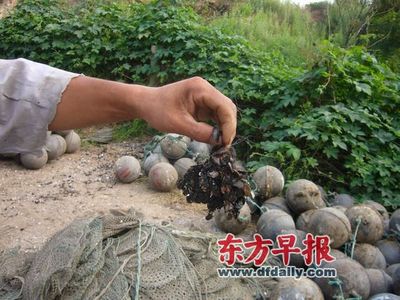Oil spill reaches beaches
 0 Comment(s)
0 Comment(s) Print
Print E-mail
China.org.cn, China Daily, July 21, 2011
E-mail
China.org.cn, China Daily, July 21, 2011
Oil from a huge spill off China's coast has been found ashore in two separate areas, authorities said on Wednesday, sparking calls for greater transparency about the disaster.
 |
|
Shellfish are stick together by oil in the coastal areas of Changdao County, Yantai, east China's Qingdao Province. But it's still unknown whether the oil were from Penglai 19-3 oilfield. |
Environmental protection organizations have warned that the spill may be on a much larger scale than previously thought.
Particles and patches of oil have been detected along coastal areas of northern Hebei Province and northeastern Liaoning Province.
|
Don't miss: |
Dried oil particles and patches, about one to three centimeters in diameter, were found at a four-kilometer stretch of beach at Dongdaihe, in Suizhong county, Liaoning province, the notice said.
An unnamed official from Suizhong oceanic and fishery bureau confirmed the news and said an operation to clean up the oil had began, without giving further details.
In Hebei, similar oil particles and patches were found on a 300-meter-long beach in Jingtang port, the SOA notice said.
Lin Fangzhong, an official with the SOA, confirmed the oil was from the Penglai leak and carried to the beaches by wind and wave, the Xinhua News Agency reported on Wednesday.
Bohai Bay is surrounded on three sides by Liaoning, Hebei, Tianjin and Shandong.
Winds usually blow from the southeast in Bohai Bay from June to August. This wind pattern has sheltered Shandong province from the pollution, Ding Zhixi, a spokesman for the Shandong provincial oceanic and fishery administration, said on Wednesday.
ConocoPhillips China declined to comment on Wednesday.
Oil patches could easily be observed near Penglai oilfield's Platform C on Tuesday amid operations to clean up the spill.
The spill at Platform B has stopped, but a sheen occasionally appears, and about 400 barrels of oily water had been collected as of Tuesday, ConocoPhillips China said.
The Houston-based energy company estimated earlier that about 1,500 to 2,000 barrels of oil and oil-based drilling fluids had gone into the sea during the two leaks at Penglai oilfield.
The amount of oil recovered may not increase significantly as most of the spill has evaporated, said Mark Nelson, vice-president of ConocoPhillips China, who led a media group on Tuesday to Platform C.
Two boats are operating in the spill area with another joining the cleanup on Wednesday, he said.
A boom, 1,180 meters long, has been deployed to prevent the sheen from spreading.
The SOA ordered the company to shut down production at the two platforms on July 13. The first incident at Platform B occurred on June 4 while the other leak, at Platform C, occurred on June 17.
"We'll wait for the SOA's approval to resume production at the two platforms," Nelson said.
Three members from the North China Sea Branch of the SOA were sent to Platform C and three to Platform B to oversee cleanup work.
One member from the branch at Platform C said that there's been no distinct progress in the cleanup so far.
No cleanup timetable was provided.
The company set a peak production target of 60,000 barrels a day at Penglai's three blocks.
The suspended production at the two platforms could reduce daily output by 17,000 barrels.
The spill, which has polluted a sea area about six times the size of Singapore, was kept secret for several weeks before being made public this month, sparking suspicions of a cover-up.
AFP quoted Greenpeace China campaigner Li Yan as saying on Wednesday that the latest report indicates a wider coastal area could eventually be affected, and urged the government and oil companies to release more information to the public.
"The biggest problem now is that the public is not aware of the potential impact," she said.
Ma Jun, director of the Institute of Public and Environmental Affairs, said on Wednesday that the SOA notice highlights a dramatic change in circumstances with pollution hitting nearby coasts.
"The impact is far more than what ConocoPhillips told the public and they should release information to the public as quickly and comprehensively as possible," Ma said.
The Penglai 19-3 oilfield is China's largest offshore oilfield, with COPC holding a stake of 49 percent in the project and CNOOC holding the rest.






Go to Forum >>0 Comment(s)